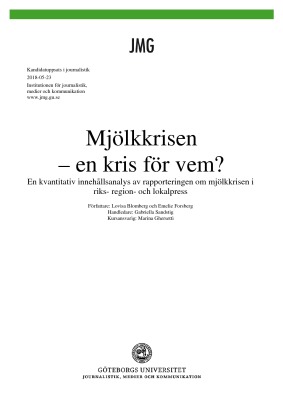Mjölkkrisen – en kris för vem?
En kvantitativ innehållsanalys av rapporteringen om mjölkkrisen i riks- region- och lokalpress
This study is a content analysis of the Swedish news media reporting of the milk crisis during the years 2014 to 2016. The aim with this study is to examine how the milk crisis was reported in the five largest newspapers and the five largest local newspapers within the countys with the highest cow density. The five largest newspapers were Dagens Nyheter, Svenska Dagbladet, Göteborgs-Posten, Dagens Industri and Sydsvenskan. The local newspaper were Hallandsposten, Barometern, Kristianstadsbladet, Vestmanlands Läns Tidning and Östgöta Correspondenten.
The study aims to find out how often the newspapers reported about the milk crisis, how much space the crisis received, how the crisis was framed and which participants that dominated. To succeed with this aim four questions were constructed.
1. How often was the milk crisis reported about and how much space did the phenomenon receive?
2. How was the milk crisis framed?
3. Which participants dominated the milk crisis?
4. How were the dairy farmers described?
The aim and questions have been answered using a quantitative content analysis together with theories about news selection, agenda setting, news frame and framing. Earlier research have also been used to support the result of the study, mainly the rural research. There was a total selection made of the articles during the time period 2014 to 2016 in the selected newspapers that contained the words “milk crisis”, “the milk crisis” or “milk + crisis”. The total material was 189 articles.
The result shows that the newspaper wrote the most about the milk crisis during 2015. Of all the articles 57 % were portrayed negative, with the peak from july to december 2015. The articles did not use cases often, only in 24 % of the articles. When the articles did use cases the majority was dairy farmers. The local newspapers used dairy farmers more frequently than the largest newspapers. The results shows that the most occuring participant was organizations and companies, both for the local newspapers and the largest newspapers.
They occured in 63 % of the articles. However, the politicians received the most space in the articles through quotes and references despite the fact that they did not occur as often. It also shows that the majority of the headlines did not mention the dairy farmers at all. In the introduction and body of text the local newspapers wrote dairy farmers more frequently than the largest newspapers while the largest newspapers wrote farmer more frequently.

